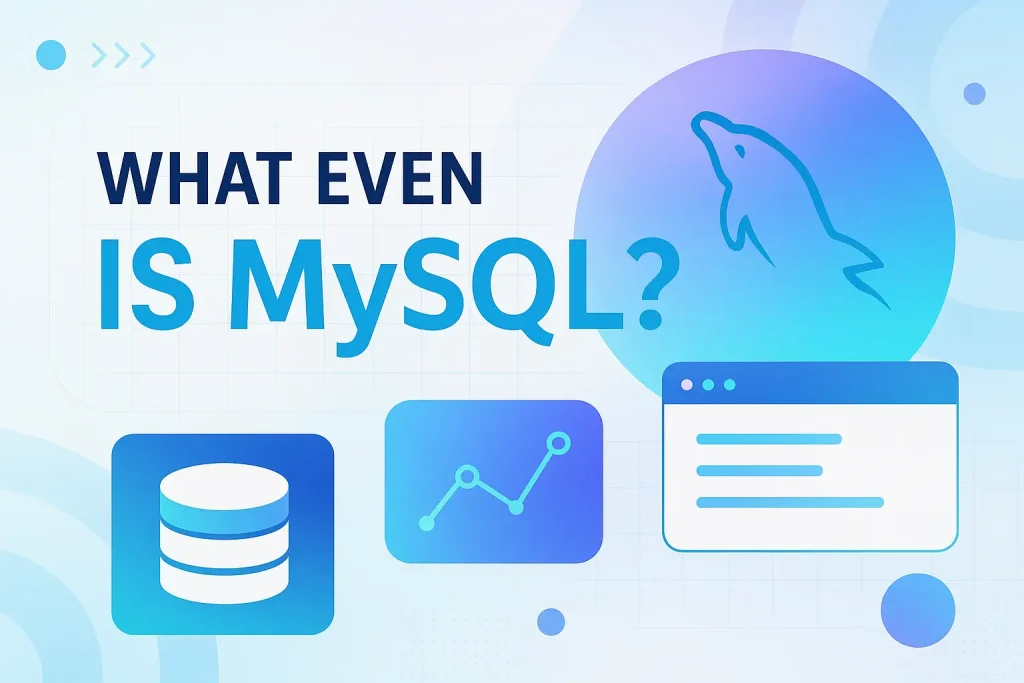Hey there! I’m Yasfa Yasmin, a web development nerd who’s been through the ups and downs of trying to get my brain to understand MySQL. If you’re new to databases or just struggling to really get a handle on MySQL, trust me—you’re not alone. I’ve been there, done that, broke everything, and somehow fixed it again. This is my story, my learnings, my real and raw experience with MySQL, and what I really wish I knew when I started.

What Even Is MySQL?
Okay, so before diving into the hard parts, let’s make sure we’re all on the same page. MySQL is a relational database management system, or RDBMS for short. That basically means it stores your data in tables and lets you play around with it using something called SQL (Structured Query Language).
Imagine you’re building a blog. You have users, blog posts, comments. Each of these can be represented as a table. Users table stores info about the authors. Posts table has blog articles. Comments table? Obvious. But how do they all connect? That’s where the power of MySQL comes in.
It’s used everywhere—small blogs, giant platforms, e-commerce systems, and even backend dashboards. It’s stable, open-source, widely supported, and honestly… intimidating at first.
But once you dig in, it starts making sense.
Mistake #1: I Ignored Database Design Principles
When I first opened up phpMyAdmin and saw “Create Table,” I jumped in without a plan. And yep—I created chaos.
My initial approach was like, “Hmm, let me create a users table and throw in name, email, and password.” That worked for a while. But then I needed posts, and then categories, and then tags, and suddenly everything was tangled up like headphone wires from 2005.
What I Wish I Knew About Schema Design:
First off, data modeling matters. If you don’t plan your data relationships from the beginning, your app will break or slow down later.
You need to think about:
- 1-to-1 relationships (e.g., user and profile)
- 1-to-many relationships (e.g., user and posts)
- Many-to-many relationships (e.g., posts and tags)
Also, learning about normalization saved me from repeating the same data in multiple tables. Here’s a breakdown:
Normalization Stages (Simplified)
- 1NF (First Normal Form): Eliminate repeating groups. Each column should contain atomic values (no arrays, lists, or multiple values).
- 2NF (Second Normal Form): Make sure every non-key column is fully dependent on the primary key.
- 3NF (Third Normal Form): Remove columns that do not depend on the primary key.
So many beginner problems (mine included) are solved by understanding normalization. Don’t skip this.
The Terrifying World of JOINs (Until They Make Sense)
JOINs scared the heck out of me. Like, why do we need them? What even is a LEFT JOIN? When do I use INNER JOIN?
But JOINs are what unlock the real power of relational databases.
Let’s say you have two tables:
userswith columns:id,namepostswith columns:id,title,user_id
If you want to show each post with its author’s name, you need a JOIN:
SELECT posts.title, users.name FROM posts JOIN users ON posts.user_id = users.id;
Once I understood JOINs as a way to “connect the dots” between related data, it finally made sense. I also learned:
- INNER JOIN gives you matching records from both tables.
- LEFT JOIN gives you all records from the left table, and matching ones from the right.
- RIGHT JOIN is the reverse of LEFT JOIN.
- FULL OUTER JOIN is not available in MySQL (you emulate it with UNION).
Common JOIN Mistakes I Made:
- Using SELECT * and not knowing what data was coming back
- Forgetting ON conditions and creating huge Cartesian products
- Not aliasing tables and getting confused with column names
JOINs aren’t scary once you practice enough. Try building tiny databases and running sample JOINs to see the results.
Query Optimization: From Sluggish to Snappy
This was a big deal for me. My web app started slowing down and I had no clue why. I thought, “But it’s just SELECT queries!”
Turns out, SQL performance is an art and science. Here’s what changed everything for me:
Indexes Are Life Savers
I had a large users table with over 10,000 rows. Searching by email took forever. Then I learned about indexes.
CREATE INDEX email_index ON users(email);
Suddenly, searches went from seconds to milliseconds. My mind was blown.
Use EXPLAIN to Debug Performance
Before:
SELECT * FROM users WHERE email = '[email protected]';
After:
EXPLAIN SELECT * FROM users WHERE email = '[email protected]';
That one word—EXPLAIN—let me see if MySQL was using an index or doing a full table scan.
Query Hygiene Tips
- Avoid
SELECT *, always choose the fields you need. - Use
LIMITto test queries without loading all rows. - Be careful with
ORin WHERE clauses—it can destroy performance.
I now write queries like I write code: clean, focused, and with performance in mind.
Backup. Backup. Backup. (Did I Mention Backup?)
One time, I accidentally deleted my production database. All my app users. All the posts. Gone. I stared at my screen for 20 minutes.
Since then, I treat backups like gold. I use cron jobs to automatically back up every day.
mysqldump -u root -p mydatabase > /backups/mydatabase_$(date +%F).sql
Always have at least:
- Daily backups
- Weekly off-site backups
- Testing of your restore process (because backup is useless if you can’t restore)
Exploring Stored Procedures and Triggers
I avoided these at first because I thought they were for “enterprise” people. But oh man, stored procedures made some of my logic cleaner and faster.
What They Are:
Stored procedures are reusable SQL blocks. You define them once and call them like functions.
DELIMITER //
CREATE PROCEDURE GetAllUsers()
BEGIN
SELECT * FROM users;
END //
DELIMITER ;
Triggers Are Like Magic Hooks
I once wanted to log every new user sign-up. Instead of handling it in my app code, I created a trigger:
CREATE TRIGGER after_user_insert AFTER INSERT ON users FOR EACH ROW INSERT INTO user_logs(user_id, action) VALUES (NEW.id, 'created');
So clean. So powerful.
Building Real Projects with MySQL
I learned the most when I started building real stuff:
- A blog CMS
- A to-do app with users
- A URL shortener with analytics
Each project helped me understand how data flows, how queries work, and what mistakes to avoid.
I used MySQL with:
- PHP (with PDO)
- Node.js (with Sequelize and raw SQL)
- Python (with MySQL Connector)
This combo helped me master both front-end and back-end logic.
Common MySQL Errors That Drove Me Mad
Error 1064: SQL Syntax Error
It’s usually a typo. Or missing quotes. Or misplacing a comma.
Error 1452: Foreign Key Constraint Fails
You’re trying to insert a record that references a non-existent value in another table.
Access Denied for User ‘root’
Either your password is wrong, or your privileges are misconfigured. Use GRANT statements correctly.
Each error, though painful, taught me a lesson. I now keep a “bug diary” to remember how I fixed them.
FAQ Section (Answers Based on My Own Experience)
Q: Is MySQL hard to learn for beginners?
A: At first, yes. But build real projects. It becomes easier when you use it daily.
Q: Should I memorize all SQL commands?
A: Nope. Just understand the logic. Then use cheatsheets or Google when you need help.
Q: My queries are slow. What do I do?
A: Use EXPLAIN. Add indexes. Refactor queries. Don’t guess—measure.
Q: Should I use MySQL or NoSQL?
A: Start with MySQL. Learn how structured data works first.
Q: Can I use MySQL with modern stacks like Node or React?
A: Yes! Backend with Node, database with MySQL, frontend with React—it works great.
Final Thoughts: Why Learning MySQL the Hard Way Was Worth It
Learning MySQL the hard way wasn’t easy. I made tons of mistakes. I deleted important data. I wrote horrible queries. I ignored database design. But all of that taught me the right way to build with confidence.
I now use MySQL daily. It powers my projects, my tools, and my career. I know how to plan schemas, write optimized queries, and debug problems fast.
So if you’re learning, don’t worry about getting it all perfect. Just keep building. Make mistakes. Learn. And come back to this post when you need encouragement.
You got this. One query at a time.
Stay curious,
Yasfa Yasmin



